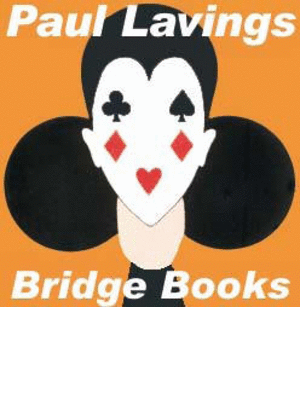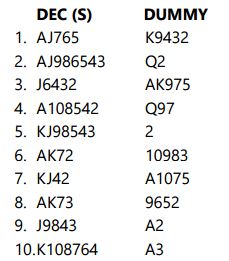 Source: ABF Bulletins
Source: ABF Bulletins
What is the best play on the following trump suits? There are no entry problems, so you may play from either hand at any point:
1) The secret to suit combinations and card play in general is to work from how many cards are missing. In this layout three cards are missing so only a 3-0 break concerns you. If Q108 lay over the Jack a trick must be lost so you should cash the King first in case the three missing cards are under the Jack. For experienced players this is an easy question but I often see it misplayed by inexperienced or sleepy players. For those who played the Ace first this is an excellent suit combination to study and understand.
2) Run the Queen. Did you count that only three cards are missing in the suit? Because of this the singleton King will not trouble you as the suit will then be breaking 2-1. You should lead the Queen first to guard against K107 with East. If West shows out after Q-K-A you then return to hand and finesse against the ten next round to lose no tricks in the suit.
3) Lead the Jack and when West follows with 8 or 10 put up the Ace. Because only three cards are missing the singleton Queen is of no concern but holding Q108 West might mistakenly cover with the queen. It costs you nothing to start with the Jack to tempt an error, if you put no pressure on the opponents then they will make very few errors indeed.
4) Play low towards Q97 and when West plays low play the 9. Running the queen and then later the 9 is 76% to lose just one trick while playing the ace first and then low to the Q9 is a 76.5% chance to lose one trick while you have the chance of losing no tricks if East has the singleton king. If you play low to the 9 first and this loses to the jack run the queen back for a finesse against the king. This line improves your chances to 80.43%. If you assume West will play the king from king-doubleton on the first round, and 99% of players would, low to the 9 first improves your chances to 93.75%, only losing when West holds K73 and East the bare jack. Thank you to Wally Malaczynski and his friends in Poland for this one.
5) If the suit breaks 3-2 it is a straight guess whether to play towards the South hand and play the nine, jack or king. However when you examine the 4-1 breaks the best play is low to the king, since this loses two tricks instead of three if the king drops the singleton queen (or 10) offside. Now you are able to force out the other two honours, and still draw the last outstanding trump with the 8 and lose two tricks in the suit instead of three. What a difference that 8 makes
6) When opponents held this suit recently declarer cashed the ace and king. East’s QJ64 sitting under AK72 suddenly became two tricks instead of none. In with the lead, East drew trumps and cashed two tricks in a long suit to defeat the contract. Queen-jack onside is a substantial 25% chance, so declarer should first run the 10. If that loses to an honour, only three cards are now outstanding, so cash the ace. If both opponents follow draw the one outstanding trump. If West shows out return to hand, and pick up the suit by finessing through East.
7) Play the King and then run the Jack. That 7 is a big card and gives you two extra chances to take four tricks in the suit when it breaks 4-1, the singleton 8 and singleton 9 in East:
If West covers the jack with the queen and East shows out come back to hand and take a second finesse to make four tricks in the suit.
8) Run the nine. When this hand came up in the 2011 VCC in Melbourne I ran the 9 and the suit was:
If the five outstanding cards divide 3-2 then nothing matters but if they divide 4-1 then only the situation above matters. Was this terribly clever? No, I had just finished reading Barry Rigal’s excellent book on technique, “Breaking the Bridge Rules”, where I came across this suit combination. The only thing it proves is that reading bridge books really can improve your results.
9) Run the Jack. If the six missing cards break 3-3 then two tricks must always be lost. When you examine the more likely 4-2 breaks (4-2=48%, 3-3=36%), leading the Jack first holds you to two losers in the suit when West holds Qx or Kx, so is the correct play when the suit includes the 8. If the play goes J-Q-A-5 how should you continue:
When you play the two and East plays the seven should you rise 8 or 9 or duck? West could have started with K5, K6, K7, K10 or KQ so rising works 3 times out of 5. What a difference the eight (and seven) makes! With J9543 opposite A2 (or J6543) the only 4-2 combination that makes any difference is when West holds doubleton 10 (KQ doubleton takes care of itself). The correct play is therefore ace and another, and when East plays low play the jack!
10) Run the ten. It’s not so easy to see the correct answer to this old chestnut. The 3-2 breaks are irrelevant, so, let’s look at the 4-1 breaks. If East has singleton Q or J then two tricks must be lost, but what if East has the bare 9? Now, leading the 10 smothers the nine. And if West covers the 10 with an honour, be it singleton or otherwise, just play back to the 8 to guarantee only one loser in the suit:
Paul Lavings




